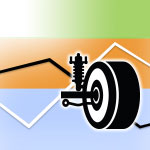About Wheel Frequency

Wheel frequency is about keeping your tires in contact with the road at (almost) all times and the springs effective for all foreseen situations.
Static Deflection
Springs are measured in kg/mm or lb/in. So for each kg placed on top of the spring it will compress by the mm value.
| Spring Rate | +Corner Weight | =Spring Deflection |
|---|---|---|
| 3 kgs/mm | 90 kg | 30 mm |
| 400 lbs/in | 220 lbs | 0.55in |
In the first example if the spring is 200 mm long out of the box, it will compress to 170 mm long when it is fitted to the car and the car is placed on its wheels. But wait! Springs are sometimes fitted at an angle or are mounted inboard behind rockers and pushrods. These factors will change the relationship between the spring compressing and the ride height changing. Thankfully, the calculators work out this relationship (called the suspension leverage).
 |
Given this model, we can build a table and return the static deflection. You can find the suspension leverage value by clicking The suspension leverage value is printed on right. |
| Spring Rate | +Corner Weight | +Suspension Leverage | =Static Deflection |
|---|---|---|---|
| 3 kgs/mm | 90 kg | 1.59:1 | 75.63 mm |
| 400 lbs/in | 220 lbs | 1.59:1 | 1.39 in |
Suspension Travel
What the static deflection gives us is the available suspension travel if you like. So if you were to find yourself on uneven ground and one of the wheels was to fall down a rut or pot hole, using the first example, the spring would still be effective if the pot hole was up to 75.63 mm deep. Equally, if your car was to roll during cornering the inside wheel spring would still remain effective as long as the wheel didn’t drop more than 75.63 mm relative to the chassis.

Downforce
If your car has downforce and you can calculate or approximate the amount of weight added at a given speed then add this value (for a given axle divided by 2) to the total corner weight. This will change the static deflection and give you the car’s true ride height at any given speed.
CPM
CPM or cycles per minute is the frequency at which the spring oscillates. That is to say, if you were to compress a spring and release it, it would bounce at the same rate (bounces per minute if you like) even if the distance it travelled during the bounce reduced over time (don’t confuse frequency and amplitude). The CPM gives a good approximation of what to aim for when selecting a spring.
| Use | From | To |
|---|---|---|
| Comfortable road car | 60 cpm | 80 cpm |
| Sports road car | 80 cpm | 100 cpm |
| Racing cars without wings or ground effects | 100 cpm | 125 cpm |
| Racing cars with downforce | 200 cpm | 350 cpm |
| Ground effect era cars | 500 cpm |
Conclusion
Selecting the right springs is a balance of achieving the correct CPM and achieving the right static deflection that gives your suspension enough travel to handle its environment.
Subscribe

to the Suspension Geometry Calculator |

to the MacPherson Geometry Calculator |

to the Wheel Frequency Calculator |
|
References
https://www.rqriley.com/suspensn.htm
http://eibach.com/america/en/motorsport/products/suspension-worksheet
https://www.qa1.net/technical-support/street-performance racing-spring-rate-tech
https://www.acxesspring.com/compression-spring-rate.html
http://www.autospeed.com/cms/article.html?&title=Springs-and-Natural-Frequencies&A=112279
http://www.optimumg.com/docs/Springs&Dampers_Tech_Tip_1.pdf
https://www.amazon.com/Competition-Car-Suspension-Practical-Handbook/dp/1844253287








